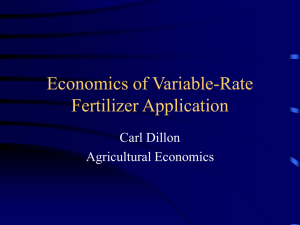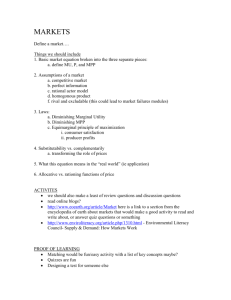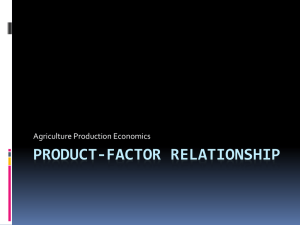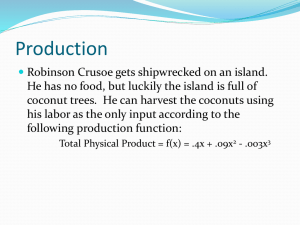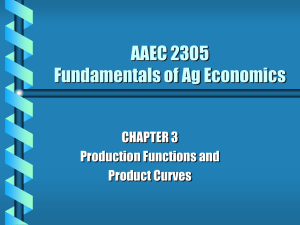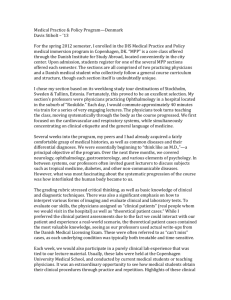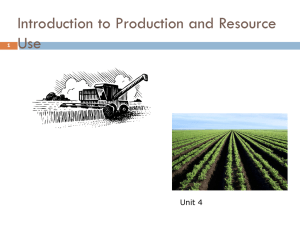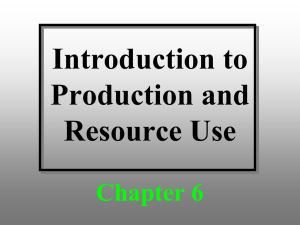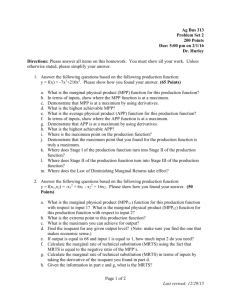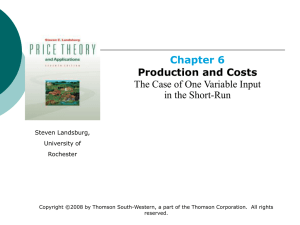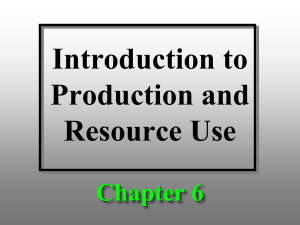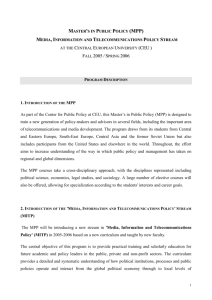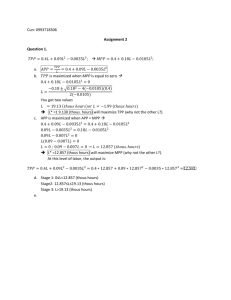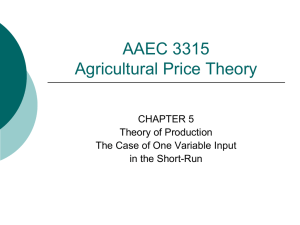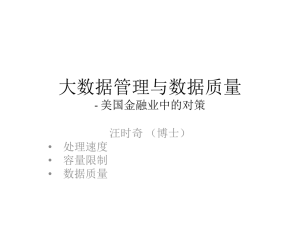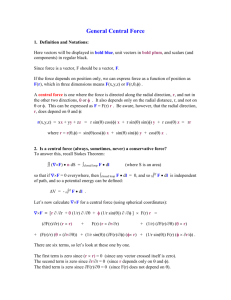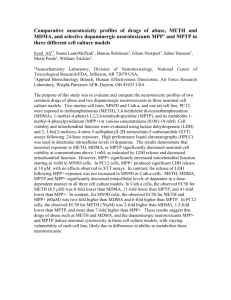Introduction to Agricultural and Natural Resources
advertisement
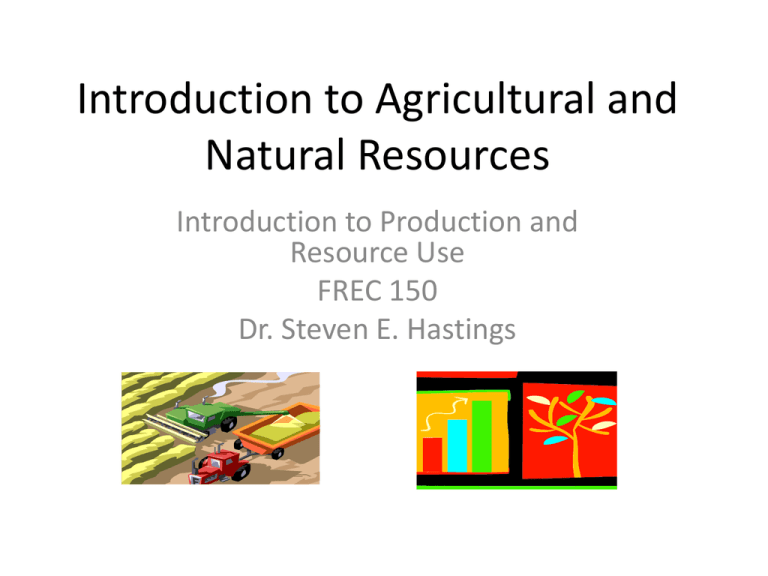
Introduction to Agricultural and Natural Resources Introduction to Production and Resource Use FREC 150 Dr. Steven E. Hastings Introduction to Production and Resource Use • • • • • • • • • • This Outline Covers the First part of Chapter 6 in Penson et al. Major Topics Production Decisions Types of Resources The Production Function – TPP, AVP and MPP Impact of Technology Value Relationships Firm’s Demand for an Input An Application of Eqi-marginal Return Summary Important Concepts • Production Decisions – Important Concepts: • Production – the process of transforming resources into goods and services (again, soil to corn flakes) • Resources - inputs (land, management, capital, etc.) • Goods and Services – provide satisfaction to consumers – Important Questions: • What to produce? How to produce? How much to produce? • Types of Resources (Inputs) – Many ways to distinguish resources. • By type: land, labor, capital and management. • Fixed and Variable – this distinction is based on the concept of the producer’s planning horizon, which varies by producer and/or good or service. • A “fixed input” can not be changed in the short-run. • A “variable input” can be changed in the short run. • In the “long-run” all inputs are variable. • The Production Function – A “model” that represents the “physical” relationship between inputs (fixed and variable) and output. – Mathematically – Y=f(X1 / X2, X3…Xn held constant) – Verbally – Y is the maximum amount of a good that can be produced with increasing amounts of X1 holding all other inputs, X2, X3…Xn, constant – given a state of technology. – Graphically – see Table 6-1 and Figure 6-1 The Production Function • Product Curves – Total Physical Product (TPP) – Average Physical Product (APP) = TPP/X1 – Marginal Physical Product (MPP) = • TPP / X1 • In a “normal shaped” production function, MPP captures the “Law of Diminishing Marginal Productivity” – as additional amounts of a variable input are added to a set of fixed inputs, the MPP will increase, reach a maximum, and then decrease. • Mathematically, MPP is the slope (rise over run) of the TPP. – Stages of Production (I, II and III) – the APP and MPP allows us to start to “narrow in” on the optimum amount for the producer to produce. • Stage I - APP is increasing (efficiency is increasing) and MPP > APP (getting more from an additional unit than the average unit). Irrational to produce in this area: can increase net revenue by moving to Stage II. • Stage II - APP > MPP and MPP is positive. Rational area to produce in. • Stage III - MPP is negative. An additional input reduces TPP. Irrational to produce in this area. Stages of Production FREC 150 – Economics of Agricultural and Natural • Effect of New Technology – New technology “shifts” the production function in a variety of ways. See Figures 3-2 and 3-3 (old book). – Typically, allows producer to get more output per unit of input over at least some range of production. – Examples: • the assembly line for car production (1908) • new seed varieties – The Green Revolution (1945) • new pesticides and herbicides • “robotic welders” Impact of New Technology • Value Relationships – Physical values (bushels of corn, for example), allow you to identify a range of possible optimal input levels – Stage II. – To identify the exact amount, need to convert the output (bushel of corn) to dollar value of the output (the value of a bushel of corn). – This is done by scaling (or multiplying) TPP, APP and MPP by the price of a bushel of corn – what a bushel of corn can be sold for in the market. – This converts • TPP to Total Value Product or TVP. • APP to Average Value Product or AVP, and • MPP to Marginal Value Product or MVP. – TVP, AVP and MVP are Dollar Values ($$) • See Table 6-5 and Figure 6-6. • For graphing purposes, the vertical axis is now in Dollars. Value Relationships Correction: 5 is 3 – 4 In Table 6-5. • Most Useful Concept – Marginal Value Product (MVP) - the amount added to "revenue" when an additional unit of the variable input is used. – MVP = TVP / X1= change in the value of output / unit change in input or – = MPPinput * Poutput • One Final Thing – The Cost of the Input – Marginal Factor Cost (MFC or MIC) measures the addition to total cost of an additional unit of an input. – MFCinput is equal the market price of the input. • Optimum Amount of a Variable Input to Use – Then optimum amount of a variable input is being used when: • MVPinput = MFCinput – The cumulative net benefit (the total revenue over the total cost of using the variable input ) is maximized! – See Table 6-5. • A Firm’s Demand for a Variable Input – It is the quantity of an input the firm would buy at alternative prices. – Specifically, the firm's demand curve for an input is the MVP curve (within Stage II of production), ceteris paribus. – The firm's demand for an input is a derived demand. That is, it is derived from the demand for the output produced by the input. – Factors that cause the demand for an input to change are: • Change in demand (and price ) of the output • Change in the productivity of the input • Change in the price of other inputs (substitutes and complements) Firm’s Demand for an Input An Application of the MVP Concept • Use of a Resource to Benefit Society – The fixed amount (1 million gallons) of water in a reservoir can be used to irrigate corn on a nearby farm or as a coolant in a nearby plant that makes X’s (any product). – You are hired by “society” and put in charge of allocating the water? • How should the water be allocated between the two uses? Information Needed • If water used to grow corn - • If water used to make X’s - Flip the Right Graph! $ $ Water to Farm Water to Plant What is the optimum allocation? Why? Principle of Equi-marginal Returns – Principle of Equi-marginal Returns – a scarce resource should be allocated between alternative uses so that the marginal returns (in this case, MVP’s) are equal in the alternative uses. – What if local environmentalists want to keep the water in place for aesthetic purposes? What about fisher-men, -women? – What are the implications for how society should allocate scarce resources? – Land? Water? Forests? Cars? >>> >>> TVs? Food? Introduction to Production and Resource Use • Summary – The combination of physical and value (dollar) relationships between inputs and output allows us to make fundamental decisions regarding resource use and allocation in our economic system. • Lecture Sources: Text and Miscellaneous Materials
